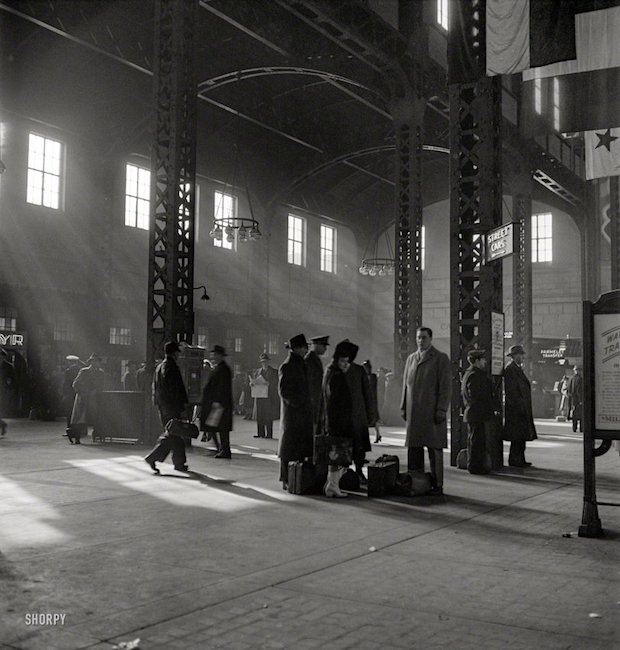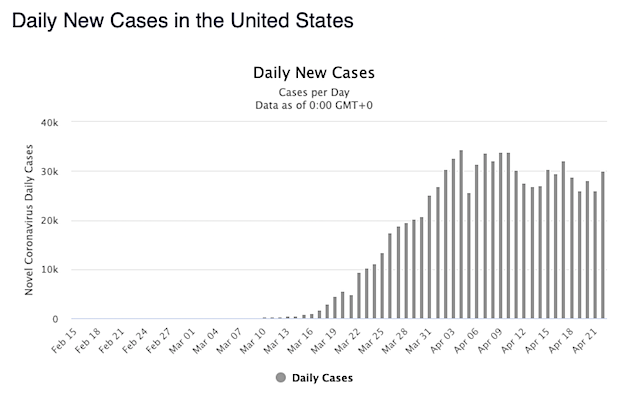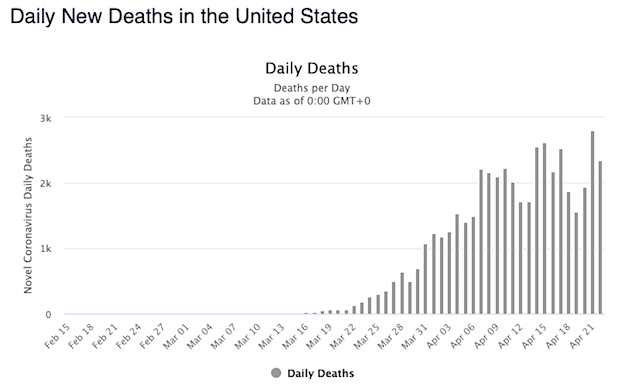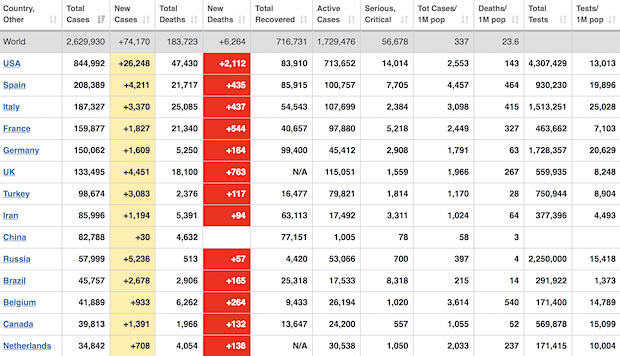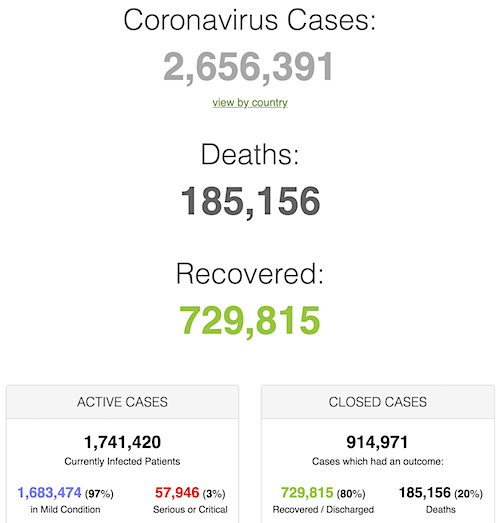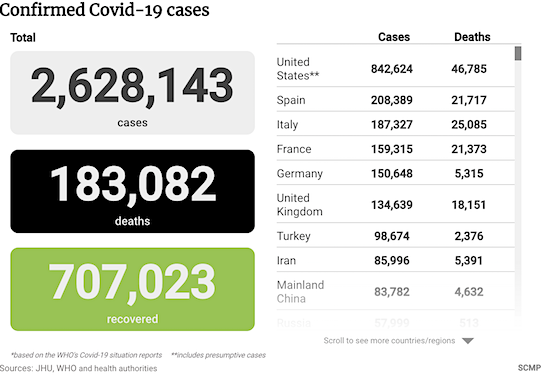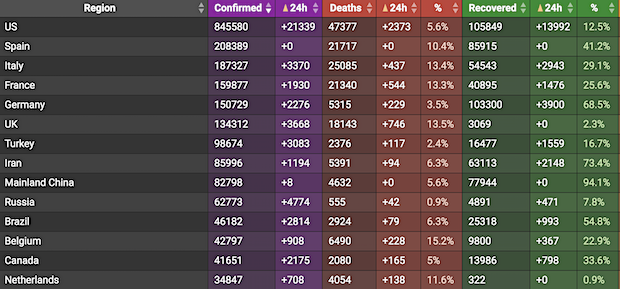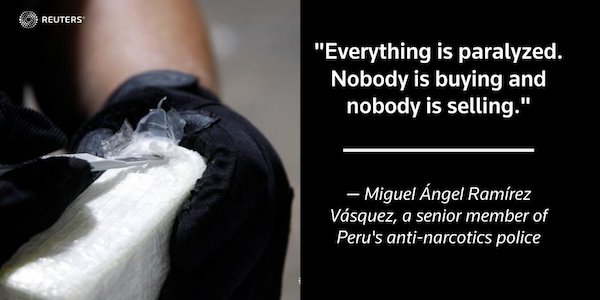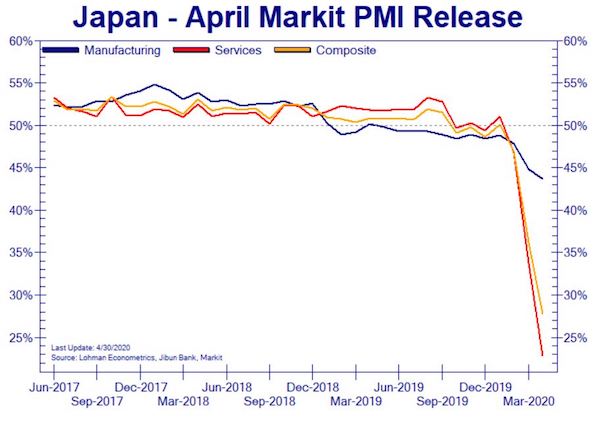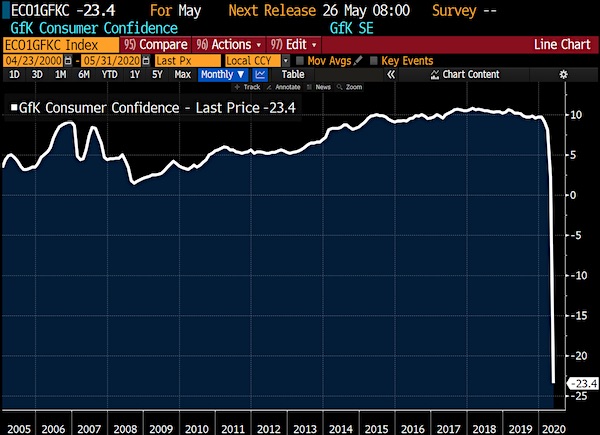
Charles Camoin Village Street in Collioure 1912

• US 21,173 new cases in past 24 hrs
• Brazil 21,472 new cases, will overtake Russia for no. 2 spot this week
• Globally, over 100,000 new cases, a new record.
The virus is spreading, and often to vulnerable areas. India, Peru, Pakistan, Chile. Rising deaths numbers to follow, if properly reported

https://twitter.com/i/status/1263196507169316864

• Cases 5,108,869 (+ 102,194 from yesterday’s 5,006,675)
• Deaths 330,082 (+ 4,762 from yesterday’s 325,320)

From Worldometer yesterday evening -before their day’s close-
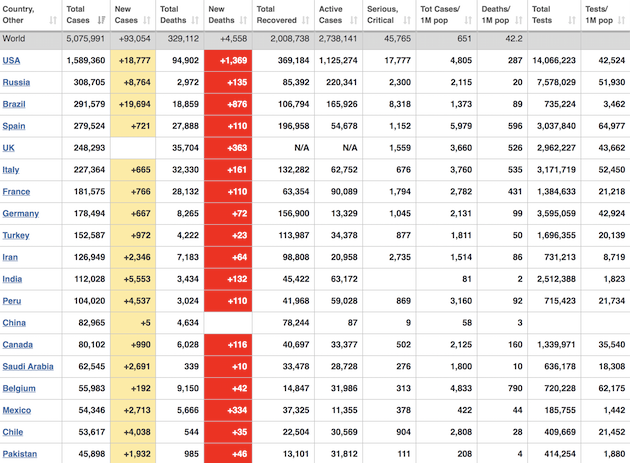
From Worldometer
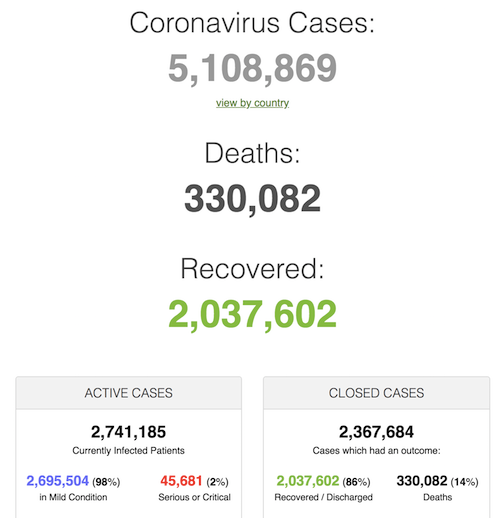
From SCMP:
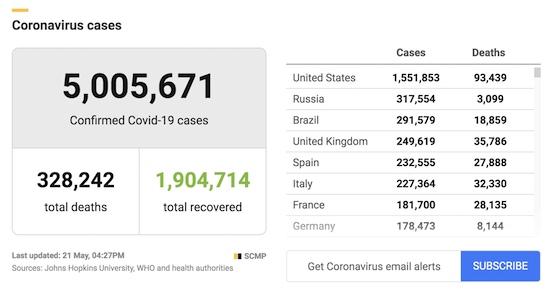
From COVID19Info.live:
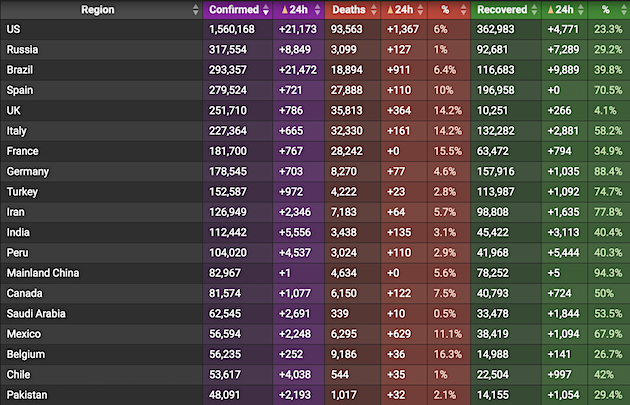

“Do not listen to the politicians who say we’re going to have one by the time my re-election comes around..”
• Don’t Count On Vaccine, US Scientist Warns (G.)
A top US scientist has said that people should not count on a Covid-19 vaccine being developed any time soon, as global infections passed 5 million after surges in Latin America, including Brazil, which has recorded nearly 20,000 new cases. William Haseltine, the groundbreaking cancer, HIV/AIDS and human genome projects researcher, has said the best approach to the pandemic is to manage the disease through careful tracing of infections and strict isolation measures whenever it starts spreading. He said that while a vaccine could be developed, “I wouldn’t count on it”, and urged people to wear masks, wash hands, clean surfaces and keep a distance. “Do not listen to the politicians who say we’re going to have one by the time my re election comes around,” he said.
“Maybe we will (but) I’m just saying it’s not a slam-dunk case by any means … because every time people have tried to make a vaccine – for Sars or Mers – it hasn’t actually protected.” Vaccines developed previously for other types of coronavirus had failed to protect mucous membranes in the nose where the virus typically enters the body, he said. The United States and other countries has not done enough to “forcibly isolate” people exposed to the virus, Haseltine said, but praised China, South Korea and Taiwan’s efforts to curb infections. Haseltine said the US, Russia and Brazil – which rank first, second and third for infections – have done the worst. As global infections passed 5 million, Brazil reported a record 19,951 cases on Wednesday, according to the ministry of health, taking total infections to 291,579.

Why bailing out businesses is a bad idea.
• 42% Of Recent US Layoffs To Result In Permanent Job Loss – Study (Y!)
Permanent job losses are likely to be a feature of the eventual U.S. recovery, according to University of Chicago research, which estimates that 42% of recently unemployed workers will not return to their jobs amid the “profound” shock stemming from coronavirus lockdowns. The pandemic has taken a brutal toll on the world’s largest economy, with at least 36 million people thrown out of work over the last two months. With states gradually relaxing restrictions that have shut down businesses and locked workers at home, economists are forecasting at least some of those employers could rehire laid off workers. However, researchers at the U of C’s Becker Institute for Economics have painted a dour picture of the labor market reallocating those lost positions.
Calling the crisis a “major reallocation shock” across all major economic sectors, the authors found that for every 10 coronavirus-induced job losses, only 3 were created. Some employers — primarily Amazon and Walmart — have hired en masse to deal with temporary demand spikes, yet the Chicago study suggests positions created during the COVID-19 crisis are unlikely to offset the labor market’s extreme bloodletting. The lockdowns have cratered activity in an economy that consists of 70% consumer spending, while undoing all of the jobs created since the great recession ended. “Even if medical advances or natural forces bring an early resolution to the crisis, many pandemic-induced shifts in consumer demand and business practices will persist,” wrote [..] the study’s authors.
They cautioned that a litany of reasons — such as generous unemployment benefits that exceed their lost job earnings, policies to encourage companies to keep people on the payroll and other regulatory factors “will impede reallocation responses to the COVID-19 shock.” As a result, “much of the near-term reallocative impact of the pandemic will also persist, as indicated by our forward-looking reallocation measures,” they wrote, adding that “42 percent of recent layoffs will result in permanent job loss.” “If the pandemic and partial economic shutdown linger for many months, or if pandemics with serious health consequences and high mortality rates become a recurring phenomenon, there will be profound, long-term consequences for the reallocation of jobs, workers and capital across firms and locations,” the U of C’s researchers wrote.

Nobody counts for just a week. But Sweden has major problems. Their numbers are going up, not down.
• Sweden Had Highest Coronavirus Death Rate Per Capita In Last Week (Tel.)
Sweden has now overtaken the UK, Italy and Belgium to have the highest coronavirus per capita death rate in the world, throwing its decision to avoid a strict lockdown into further doubt. According to figures collated by the Our World in Data website, Sweden had 6.08 deaths per million inhabitants per day on a rolling seven-day average between May 13 and May 20. This is the highest in the world, above the UK, Belgium and the US, which have 5.57, 4.28 and 4.11 respectively. However, Sweden has only had the highest death rate over the past week, with Belgium, Spain, Italy, the UK and France, still ahead over the entire course of the pandemic. State epidemiologist Anders Tegnell, the spokesman for Sweden’s outlier coronavirus strategy, dismissed the figures on Tuesday night, arguing that it was misleading to focus on the death toll over a single week….
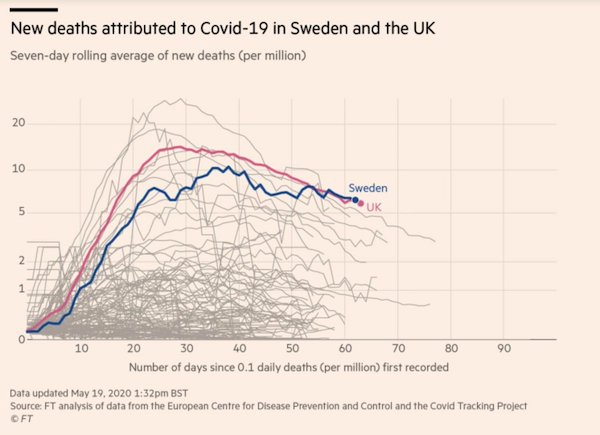

We were having a discussion in the Comments at the Automatic Earth the other day, specifically about “hemolytic anemia in people with glucose-6-phosphate dehydrogenase (G6PD) deficiency”, a problem linked to Chloroquine (CQ), but not Hydroxychloroquine (HCQ). 400 million people worldwide, and 1 in 10 African-American males in the U.S have G6PD deficiency.
It was mentioned that the closely related primaquine (not chloroquine) appears to be the drug of choice to fight malaria worldwide, and that primaquine also is problematic for G6PD-deficient patients. Though the numbers don’t reflect that: “In six decades of primaquine use in approximately 200 million people, 14 deaths have been reported.” Not a big issue. If that is what is meant by the danger imposed by hydroxychloroquine, I’ll take it.
And there was this curious line: “G6PD deficiency provides great protection from malaria infection, especially for falciparum infections. On the other hand, G6PD deficiency has been recently demonstrated to cause serious problems in fighting against malaria.
• YouTube Censors Video In Which Medical Doctors Said HCQ Might Help (JTN)
YouTube on Wednesday reinstated a video it has previously censored in which several medical doctors suggested that the drug hydroxychloroquine might be useful in treating coronavirus, with the company reportedly claiming at the time of censorship that the presentation was “dangerous.” The video report, presented by Sharyl Attkisson at Full Measure News, examined the possible benefits of hydroxychloroquine as a treatment for COVID-19 and the possible financial interest some parties have in downplaying the drug and promoting a separate treatment called remdesivir. One of the doctors interviewed in the video, William O’Neill, tells Attkisson, also a Just the News contributor, that there is “some value” to hydroxychloroquine and “it has to be tested.”
O’Neill, a cardiologist in Detroit, has prescribed the drug to multiple patients and “saw improvement in all of them,” Attkisson reported. At the Henry Ford Health System, where O’Neill works, officials are working with hydroxychloroquine and remdesivir. The doctor said the media campaign against the drug, which began around the time President Trump first started touting it, has left patients “scared to use the drug without any scientifically valid concern.” “We’ve talked with our colleagues at the University of Minnesota who are doing a similar study, and at the University of Washington,” he said. “We’ve treated 400 patients and haven’t seen a single adverse event. And what’s happening is because of this fake news and fake science, the true scientific efforts are being harmed because people now are so worried that they don’t want to enroll in the trials.”
Another physician, Dr. Jane Orient, the executive director of the Association of American Physicians and Surgeons as well as a clinical lecturer at the University of Arizona College of Medicine, urged viewers to “look at the money” when it comes to the two drugs. “There’s no big profits made in hydroxychloroquine,” said Orient. “It’s very cheap, easy to manufacture, been around for 70 years. It’s generic. Remdesivir is a new drug that could be very expensive and very lucrative if it’s ever approved. So I think we really do have to consider there’s some financial interest involved here.” Sharyl Attkisson on Wednesday afternoon told Just the News that it wasn’t immediately clear when the video was removed
It was originally uploaded to YouTube two days ago. Attkisson said YouTube had removed the presentation with a note claiming that it was “dangerous,” without offering any explanation as to why. She said Full Measure News appealed the removal, after which YouTube subsequently reinstated it. Attkisson cited a critical report by Media Matters, published the same day as her report, as the likely cause of the removal. “These are organized efforts,” she said, arguing that politically biased parties are behind efforts to remove or censor contrarian information on social media. “They know they can use these systems to limit information. It’s very frightening because I feel like if something’s not done, in five years, we’re going to be telling our kids, ‘There was once a time we could get any information we wanted on the Internet.’ That’s changing. We can’t anymore.”
She noted recent efforts by Democratic Rep. Adam Schiff, the chairman of the House Intelligence Committee, to pressure social media companies to censor and downgrade “harmful” coronavirus-related material and push users instead toward information from the World Health Organization. “I don’t know why we’re allowing this,” Attkisson said. “Nobody appointed Adam Schiff to police our content on social media.”

Sharyl Attkisson also has some personal pain.
• Media Matters and its Propaganda About Hydroxycholoroquine (Attkisson)
For most thinking Americans, it is unnecessary to bother to fact check the propaganda group Media Matters. If they have heard of Media Matters at all, they typically understand it’s a smear group funded by donors with political and corporate interests whose names are kept secret. (The last big Media Matters donor whose name was publicly revealed years ago was that of liberal billionaire activist George Soros.) The problem is, too many news organizations and even journalism groups such as Poynter use Media Matters and their affiliates as if they are legitimate news sources. They are either unforgviably ignorant of Media Matters’ slants— or choose to keep readers in the dark because they agree with the slant. One major interest Media Matters and its affiliates have served over the years is that of the pharmaceutical industry. They often smear scientists and journalists who report on prescription drug and vaccine safety issues, falsely labelling them as “anti-vaccine.”
The segment mentioned both positive and negative scientific findings about hydroxychloroquine and remdesivir. It did not attempt to take a comprehensive look at all of the studies underway or completed (there are hundreds); or their methodology, limits and criticism. It was to show that some well regarded, peer-reviewed, independent, published scientists who are actually studying hydroxychloroquine, and have no financial connections to the makers of the drug, have a different opinion than what has been widely presented in the media. It was also to show that the government, academic institutions and hospitals are actively studying hydroxycholorquine as both a preventive agent and treatment for coronavirus. Further, the esteemed scientists consulted do not agree with Media Matters’ spin on the topic, and it is their prerogative to present their scientific opinion. It’s important to hear from scientists who hold differing views on matters of public health importance.
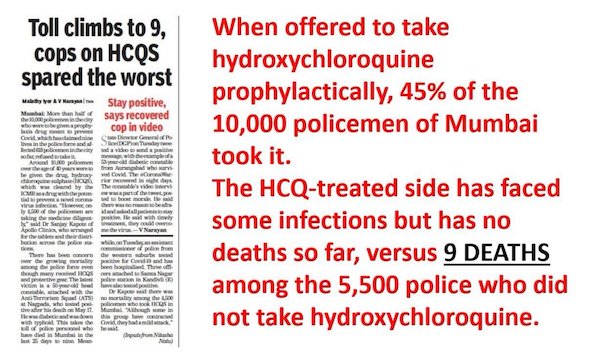

It can be done safely, but will it?
• Apple-Google Contact Tracing Tech Draws Interest In 23 Countries (R.)
Authorities in 23 countries across five continents have sought access to contact tracing technology from Apple Inc and Alphabet Inc’s Google, the companies announced on Wednesday as they released the initial version of their system. But authorities would have to stop requiring phone numbers from users under the companies’ rules, one of several restrictions that have left governments fighting the novel coronavirus frustrated that the world’s top two smartphone software makers undercut the technology’s usefulness by prioritizing user privacy. Apple and Google said several U.S. states and 22 countries have sought access to their technology, but it is unclear how many will end up publishing mobile apps that use it.
Using apps to accelerate contact tracing, in which authorities identify and test people who were recently near a virus carrier, has emerged as a tool to stem new outbreaks. It could help authorities test more potentially infected individuals than they would normally be able to based on patients recalling recent interactions from memory. But some governments contend their app-based efforts would be more effective if they could track users’ locations to identify hot spots for virus transmission and notify them about possible exposure through calls or texts, rather than a generic push notification. Apple and Google have barred authorities using their technology from collecting GPS location data or requiring users to enter personal data.
“We have a collision of tech, privacy and health professionals and the Venn diagram doesn’t really have a spot where they all overlap,” said Chester Wisniewski, a principal research scientist at cybersecurity company Sophos. Australia, the United Kingdom and other countries that have sought to develop their own technology are experiencing glitches, draining device batteries and seeing limited adoption. Apple and Google have said their system will more reliably use Bluetooth connections between devices to log users who are in physical proximity for at least five minutes.

You can say this about almost every “leader”. Incompetence.
• Andrew Cuomo’s No Hero. He’s To Blame For New York Coronavirus Catastrophe (G.)
Andrew Cuomo may be the most popular politician in the country. His approval ratings have hit all-time highs thanks to his Covid-19 response. Some Democrats have discussed him as a possible replacement for Joe Biden, due to Biden’s perceived weakness as a nominee. And there have even been some unfortunate tributes to Cuomo’s alleged sex appeal. All of which is bizarre, because Cuomo should be one of the most loathed officials in America right now. ProPublica recently released a report outlining catastrophic missteps by Cuomo and the New York City mayor, Bill de Blasio, which probably resulted in many thousands of needless coronavirus cases. ProPublica offers some appalling numbers contrasting what happened in New York with the outbreak in California.
By mid-May, New York City alone had almost 20,000 deaths, while in San Francisco there had been only 35, and New York state as a whole suffered 10 times as many deaths as California. Federal failures played a role, of course, but this tragedy was absolutely due, in part, to decisions by the governor. Cuomo initially “reacted to De Blasio’s idea for closing down New York City with derision”, saying it “was dangerous” and “served only to scare people”. He said the “seasonal flu was a graver worry”. A spokesperson for Cuomo “refused to say if the governor had ever read the state’s pandemic plan”. Later, Cuomo would blame the press, including the New York Times for failing to say “Be careful, there’s a virus in China that may be in the United States?” even though the Times wrote nearly 500 stories on the virus before the state acted.
Experts told ProPublica that “had New York imposed its extreme social distancing measures a week or two earlier, the death toll might have been cut by half or more”. But delay was not the only screw-up. Elderly prisoners have died of coronavirus because New York has failed to act on their medical parole requests. As Business Insider documented: “Testing was slow. Nonprofit social-service agencies that serve the most vulnerable couldn’t get answers either. And medical experts like the former CDC director Tom Frieden said ‘so many deaths could have been prevented’ had New York issued its stay-at-home order just ‘days earlier’ than it did. On March 19, when New York’s schools had already been closed, Cuomo said ‘in many ways, the fear is more dangerous than the virus.’”

Keeping China out of the US.
• Senate Passes Bill On Oversight Of Chinese Companies (CNBC)
The Senate passed legislation on Wednesday that could ban many Chinese companies from listing shares on U.S. exchanges or raising money from American investors without adhering to Washington’s regulatory and audit standards. The bill, sponsored by Louisiana Republican Sen. John Kennedy, would require companies to certify that “they are not owned or controlled by a foreign government.” Alibaba, an e-commerce giant based in China, saw its U.S.-listed shares fall more than 2% on the news. Though the law could be applied to any foreign company that seeks access to U.S. capital, lawmakers say the move to strengthen disclosure requirements is aimed principally at Beijing.
“The Chinese Communist Party cheats, and the Holding Foreign Companies Accountable Act would stop them from cheating on U.S. stock exchanges,” Kennedy, a member of the Senate Banking Committee, wrote Tuesday afternoon on Twitter. “We can’t let foreign threats to Americans’ retirement funds take root in our exchanges.” Specifically, the statute would require a foreign company to certify it’s not owned or manipulated by a foreign government if the Public Company Accounting Oversight Board is unable to audit specified reports because the company uses a foreign accounting firm not subject to inspection by the board. If the board is unable to inspect the company’s accounting firm for three consecutive years, the issuer’s securities are banned from trade on a national exchange.

Things are leaking from inside the campaign, in particular accusations that Bernie was taking money from rich people. I stopped being interested when he sold out his small donors a second time.
• First as Tragedy, Then as Farce: The Collapse of the Sanders Campaign (AA)
The Warren rationalization also raises the question of why so many pro-Bernie commentators and publications were writing pro-Warren commentary until just a few months ago, with many of them even condemning her left-wing critics as toxic before moving in lockstep against her when it was too late. Notably, these same publications and personalities were ruthlessly hostile toward Tulsi Gabbard – a relatively minor candidate electorally speaking, but one who actually defended Sanders at critical junctures, including when he was under attack by Warren. After Liz ambushed Bernie with a far-fetched story purporting to cast him as a malevolent sexist, it was Tulsi who rose to his defense. (Sanders advisers eventually admitted that the sexism attack “inflicted permanent damage” on his candidacy.)
And when Warren mused that it might, after all, be just fine for superdelegates to thwart Sanders’s nomination even if he entered the convention with the most pledged delegates, Gabbard was the only other candidate to object. And when Sanders permitted himself to be “Russiagated” in the critical period before the South Carolina primary – appearing to accept the nonsensical premise of a Washington Post article alleging that the all-powerful Vladimir Putin was once again “interfering” in U.S. democracy, this time on Sanders’s behalf – it again fell to Gabbard to defend him more vigorously than even Sanders chose to defend himself

Was there a problem for the banks already when the bailout was given? What will happen when people stop paying their mortgages and car loans? Endless bailouts?
• Another Bank Bailout Under Cover of a Virus (Ellen Brown)
In March 2020, under cover of a national crisis, the Fed therefore flung the doors open to its discount window, where only banks could borrow. Previously, banks were reluctant to apply there because the interest was at a penalty rate and carried a stigma, signaling that the bank must be in distress. But that concern was eliminated when the Fed announced in a March 15 press release that the interest rate had been dropped to 0.25% (virtually zero). The reserve requirement was also eliminated, the capital requirement was relaxed, and all banks in good standing were offered loans of up to 90 days, “renewable on a daily basis.” The loans could be continually rolled over, and no strings were attached to this interest-free money – no obligation to lend to small businesses, reduce credit card rates, or write down underwater mortgages. Even J.P. Morgan Chase, the country’s largest bank, has acknowledged borrowing at the Fed’s discount window for super cheap loans.
The Fed’s scheme worked, and demand for repo loans plummeted. But unlike in Canada, where big banks slashed their credit card interest rates to help relieve borrowers during the COVID-19 crisis, US banks did not share this windfall with the public. Canadian interest rates were cut by half, from 21% to 11%; but US credit card rates dropped in April only by half a percentage point, to 20.15%. The giant Wall Street banks continued to favor their largest clients, doling out CARES Act benefits to them first, emptying the trough before many smaller businesses could drink there. In 1969, Prime Minister Indira Gandhi nationalized 14 of India’s largest banks, not because they were bankrupt (the usual justification today) but to ensure that credit would be allocated according to planned priorities, including getting banks into rural areas and making cheap financing available to Indian farmers. Congress could do the same today, but the odds are it won’t. As Sen. Dick Durbin said in 2009, “the banks … are still the most powerful lobby on Capitol Hill. And they frankly own the place.”

Somehow I doubt it.
• Turn Out the Lights, Russiagate is Over (Ray McGovern)
Given the diffident attitude the Security State plotters adopted regarding hiding their tracks, Durham’s challenge, with subpoena power, is not as formidable as were he, for example, investigating a Mafia family. Plus, former NSA Director Adm. Michael S. Rogers reportedly is cooperating. The handwriting is on the wall. It remains to be seen what kind of role in the scandal Barack Obama may have played. But former directors James Comey, James Clapper, and John Brennan, captains of Obama’s Security State, can take little solace from Barr’s remarks Monday to a reporter who asked about Trump’s recent claims that top officials of the Obama administration, including the former president had committed crimes. Barr replied:
“As to President Obama and Vice President Biden, whatever their level of involvement, based on the information I have today, I don’t expect Mr. Durham’s work will lead to a criminal investigation of either man. Our concerns over potential criminality is focused on others.” In a more ominous vein, Barr gratuitously added that law enforcement and intelligence officials were involved in “a false and utterly baseless Russian collusion narrative against the president. It was a grave injustice, and it was unprecedented in American history.” Meanwhile, the corporate media have all been singing from the same sheet since Trump had the audacity a week ago to coin yet another “-gate” — this time “Obamagate.” Leading the apoplectic reaction in corporate media, Saturday’s Washington Post offered a pot-calling-the-kettle-black pronouncement by its editorial board entitled “The absurd cynicism of ‘Obamagate”?
The outrage voiced by the Post called to mind disgraced FBI agent Peter Strzok’s indignant response to criticism of the FBI by candidate Trump, in a Oct. 20, 2016 text exchange with FBI attorney Lisa Page: Strzok: I am riled up. Trump is a f***ing idiot, is unable to provide a coherent answer. Strzok – I CAN’T PULL AWAY, WHAT THE F**K HAPPENED TO OUR COUNTRY … Page– I don’t know. But we’ll get it back. We’re America. We rock. Strzok– Donald just said “bad hombres” Strzok– Trump just said what the FBI did is disgraceful.

Endless regurgitation.
• US Supreme Court Blocks Disclosure Of Mueller Grand Jury Material (R.)
The U.S. Supreme Court on Wednesday blocked the disclosure to a Democratic-led House of Representatives committee of grand jury material redacted by President Donald Trump’s administration from former Special Counsel Robert Mueller’s report documenting Russian interference in the 2016 presidential election. In a brief order, the justices put on hold a March ruling by the U.S. Court of Appeals for the District of Columbia Circuit that the material must be disclosed to lawmakers. The order gave the administration until June 1 to formally appeal that ruling, meaning that if the justices decide to hear the case a final resolution may not be reached until after the Nov. 3 election in which the Republican president is seeking a second four-year term.
If the justices refuse to hear the appeal, the materials would need to be handed over. Mueller submitted his report to U.S. Attorney General William Barr in March 2019 after a 22-month investigation that detailed Russian hacking and propaganda efforts to boost Trump’s candidacy as well as multiple contacts between Trump’s campaign and Moscow. Barr, a Trump appointee who Democrats have accused of trying to protect the president politically, released the 448-page report in April 2019 with some parts redacted. Some Democrats have expressed concern that Barr used the redaction process to keep potentially damaging information about Trump secret.

Time for Durham.
• FBI Offered To Pay Steele ‘Significantly’ To Dig Up Dirt On Michael Flynn (DC)
An FBI offer to pay former British spy Christopher Steele to collect intelligence on Michael Flynn in the weeks before the 2016 election has been one of the more overlooked revelations in a Justice Department inspector general’s report released in December. The reference to the FBI proposal, which was made in an Oct. 3, 2016, meeting in an unidentified European city, has received virtually no press attention. But it might have new significance following the recent release of government documents that show that Steele peddled an unfounded rumor that Flynn had an extramarital affair with a Russian woman in the United Kingdom. It is not clear how and when Steele came across the rumor, or if it was the result of the FBI asking him to look into Flynn.
The inspector general’s report, released on Dec. 9, 2019, said that FBI agents offered to pay Steele “significantly” to collect intelligence from three separate “buckets” that the bureau was pursuing as part of Crossfire Hurricane, its counterintelligence probe of four Trump campaign associates. One bucket was “Additional intelligence/reporting on specific, named individuals (such as [Carter Page] or [Flynn]) involved in facilitating the Trump campaign-Russian relationship,” the IG report stated. FBI agents also sought contact with “any individuals or sub sources” who Steele could provide to “serve as cooperating witnesses to assist in identifying persons involved in the Trump campaign-Russian relationship.”
Steele at the time had provided the FBI with reports he compiled alleging that members of the Trump campaign had conspired with the Kremlin to influence the 2016 election. An FBI agent provided Steele with a “general overview” of the ongoing Crossfire Hurricane probe, according to the IG report. The agent told Steele about the actions of George Papadopoulos, a Trump campaign aide, and said the FBI had undertaken a “small analytical effort” that centered on Paul Manafort, Carter Page and Flynn. Some FBI agents who attended the meeting questioned whether the lead agent had disclosed too much to Steele about Crossfire Hurricane, according to the IG report.
[..] In the FBI memo, the Washington Field Office proposed closing a counterintelligence investigation of Flynn because investigators found no evidence that he was acting as an agent of Russia. Peter Strzok, the deputy chief of counterintelligence, intervened at the last minute to keep the investigation open after the FBI obtained a transcript of Flynn’s phone calls in late December 2016 with Russian ambassador Sergey Kislyak. Strzok helped set the “primary objectives” for the FBI meeting with Steele in October 2016, the IG report also stated.

The story that will compete with corona this summer.
• Susan Rice Email Confirms Flynn Was Targeted In Oval Office Meeting (Fed.)
Michael Flynn was personally targeted during a crucial Jan. 5, 2017 Oval Office meeting arranged by then-President Barack Obama, a newly declassified document shows. On Jan. 20, 2017, as President Donald Trump was being inaugurated, former White House National Security Adviser Susan Rice sent herself a bizarre email detailing the Jan. 5 meeting between her, Obama, then-Vice President Joe Biden, then-Deputy Attorney General Sally Yates, and fired former Federal Bureau of Investigations Director James Comey. In the email, portions of which were not declassified until recently, Rice recorded that Flynn, who at the time was the incoming national security adviser for Trump, was personally discussed and targeted during the meeting with Obama.
“From a national security perspective, President Obama said he wants to be sure that, as we engage with the incoming team, we are mindful to ascertain if there is any reason we cannot share information fully as it relates to Russia.” At the time, the Obama administration was actively spying on members of the Trump team as part of its Crossfire Hurricane investigation against Trump. “Comey said he does have some concerns that incoming NSA Flynn is speaking frequently with Russian Ambassador Kislyak,” Rice wrote in a portion of the email that was only recently declassified. “Comey said that could be an issue as it relates to sharing sensitive information.”
“President Obama asked if Comey was saying the NSC should not pass sensitive information related to Russia to Flynn,” Rice continued. “Comey replied ‘potentially.’” “[Comey] added that he has no indication thus far that Flynn has passed classified information to Kislyak, but he noted that ‘the level of communication is unusual.’” The email did not explain how it would be “unusual” for an incoming national security adviser to converse with foreign leaders ahead of a new president’s inauguration.

Almost as insane as the Assange tale. He got a $9.5 billion verdict against Chevron. Then they went after him.
• Judge Orders Attorney Steven Donziger Under House Arrest Until September (IC)
A federal judge ruled this week that environmental attorney Steven Donziger must remain on house arrest until September. The decision means that by the time his trial begins, Donziger, who represented Indigenous people and farmers in a decadeslong legal battle against Chevron and has been confined to his Manhattan apartment and required to wear an electronic ankle monitor since August, will have spent 13 months in home detention awaiting trial on charges that carry a maximum sentence of six months. In a telephone conference on Monday, District Judge Loretta A. Preska said that the trial of Donziger on contempt of court charges stemming from his refusal to give his cellphone and computer to the court will be delayed until September 13 because of the coronavirus pandemic.
While Donziger’s attorneys requested that he be released from home confinement until then, Preska said that she believed the lawyer was a flight risk and must continue to remain confined to his home. In another significant setback for Donziger, who has been the target of an aggressive legal attack from Chevron after winning a $9.5 billion judgment against the company over environmental devastation in Ecuador, Preska also decided that the attorney was not entitled to a jury trial. While the judge had already denied Donziger’s motion requesting a jury trial in a May 7 hearing, in the phone conference this week, one of his attorneys, Andrew Frisch, said that he believed her earlier ruling had left open the possibility that Donziger could face a penalty of more than six months in prison, which would have entitled him to have his case heard by a jury. But during the phone conference, Preska made it clear that that was not the case.
It is not the first time that Donziger has tried — and failed — to get his case heard by his peers. In 2007, after Donziger and other attorneys sued Chevron over water and soil contamination resulting from oil drilling in the Lago Agrio region of Ecuador, the company successfully moved to have the case heard in the Ecuadorian courts, which don’t hold jury trials. And in 2011, after Donziger’s team won an $18 billion judgment from Chevron (an award that was later reduced to $9.5 billion), Chevron filed a Racketeer Influenced and Corrupt Organizations, or RICO, suit against Donziger. Although the company initially sought significant financial damages in that case, which would have entitled Donziger to a jury trial, the company dismissed the monetary claims weeks before the trial and Donziger again faced trial without a jury. Instead, Judge Lewis A. Kaplan, who decided the RICO case, found that the judgment against Chevron had been the result of fraud.

We try to run the Automatic Earth on people’s kind donations. Since their revenue has collapsed, ads no longer pay for all you read, and your support is now an integral part of the interaction.
Thank you.



Support the Automatic Earth in virustime.


